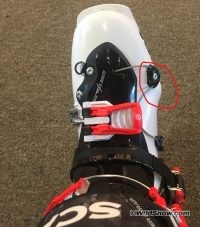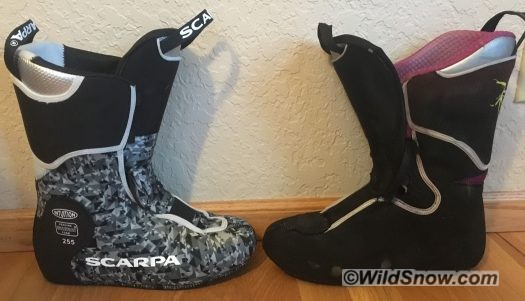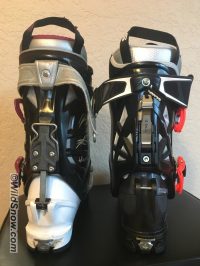(This post sponsored by our publishing partner Cripple Creek Backcountry.)
Who loves boots that fit just right? Me, me, ME! After trying numerous models, four years ago I became the owner of SCARPA Gea RS and loved them from day one. As I mentioned in my overview of women’s boots at Outdoor Retailer last year, my feet don’t like ski boots. My wide forefoot aches and hurts in most boots. The process of fitting ski boots might be my least favorite part about skiing. It seems to get more time consuming and frustrating each time I do it.
I got an opportunity to test a pair of pre-production SCARPA Gea RS 2 boots last spring and just got a production pair early this winter. Since Louie already did an amazing job describing the differences between versions of the men’s Maestrale, I will focus more on the fit of the RS V2 as well as the differences I have noticed compared to my older adored pair of Gea RS. (Note: Gea is basically the same boot as Maestrale, with the main difference purported to be the flex. If you ask me, I say the biggest difference is the color.)
SCARPA flex for Maestral and Gea (manufacturer’s specs)
— Maestrale RS, 130 flex
— Gea RS, 120 flex
— Maestrale, 110 flex
— Gea, 100 flex
First things first, the sizing (BSL) is the same as the previous Gea.
Next, let’s talk about fit. I got the boots molded and spent a few hours wearing them around the house to find any hotspots to punch. For me it tends to be in the place where my foot is widest: the “sixth toe” area primarily. When it came to getting the right punches in, I gotta give Greg Louie at Evo Seattle a big shout-out — I appreciate his patience and all his help to get my feet into a happy state!
The punches on these boots are a bit more noticeable than the previous Gea. I think the reason for this is the Grilamid shell construction of the boot; the thinner, lighter plastic is quite the art to punch! I ended up punching both boots in the widest part of my forefoot area. A very similar experience that I had with the original Gea RS. One thing to note, since the new boot version does have carbon areas in the shell, the spots that have carbon will not be as easy to punch. The black carbon plastic is easy to see. Take a close look at where your common pressure points are and if they happen to be near or on those spots, these boots are probably not be for you. (This is mostly an issue for people who need punches in the heel area of the boot.)
A few other things to highlight; I personally do not use the lace feature of the liner – but it is still available, same as on older models. The move from four to three buckles I am a fan of, since I found the 4th lower buckle redundant and I never used it.
The one frustrating aspect that I noticed over time is it was easy to misalign the plastic parts of the tongue and shell when buckling up, this has caused a bit of wear and tear, as well as slight bending in the plastic. Make sure you pay attention to which piece goes below and which one goes under when bucking in. This is actually written on the boots. I know it sounds simple, but I somehow ended up screwing this up more than once. User error or a con on the Gea? Probably a bit of both.
I will not miss the broken tongue hinges of the old version, but I will miss how simple it was to get the liner in and out. On the Gea V2, I struggle to get the liner back into the boot, even if I am wearing it.There might be a trick or a better way to do it that I haven’t figured out. I’ll report back if I come up with anything. I have heard from other new RS owners that they struggle with this as well.
The lower weight is definitely noticeable. I love the increase in the range of motion in the walk mechanism, the boots feel like bunny slippers for uphill travel. It’s incredible, yet, it doesn’t stop there. Switching into ski mode, it gets better.
I did not notice a difference in stiffness between the old and the new Gea RS. I’d say in my opinion they are right about the same. However, flexing the new Gea RS actually felt a lot more “natural,” which I think it due to the new style of the carbon infused Grilamid plastic. The flex is more progressive compared to the old RS. For me, the boot skis about 100% better than before: it’s more responsive, it has more control, it feels more forgiving on my shins. I am not sure if this is due to its shedded weight or the feel of the new plastic, but I absolutely love skiing this boot in all terrain and conditions.
I’ve skied my previous Gea for four years which to me shows that Scarpa makes a durable product. I did experience broken hinges, which I actually never ended up replacing, as this didn’t impact the performance of the boot. I expect the same durability from the V2, which to me justifies the pricey-ness of the boot.
Bottom line: Switching to the new Gea RS boot is worth all the headaches of the boot fitting process. The upgraded features you get with the newer version will leave you happier and more efficient on both the up and the down. Gea RS lovers out there — this boot is the upgrade you have been looking for. Never tried the Gea before? This would be a perfect first pair to start with!
SCARPA Gea RS, manufacturer’s specs:
Size: 22.5 – 27 (half sizes)
Weight: 1260 g; 2 lbs 13 oz (1/2 pair, size 25)
Shell, Cuff, Tongue: Carbon Grilamid, Grilamid, Pebax
Liner: Intuition Cross Fit Pro Flex G
Last: 101mm
Flex: 120
Ski/walk mode: Speed Lock Plus
Closure: 3 buckles + finger strap
Forward lean: 16° +/- 2°
Range of motion: 60° (23 more than its predecessor)
Outsole: Vibram
WildSnow Girl, Julia Dubinina, is a weekend warrior chasing snow in winter and sun in summer. A lover of long tours and steep skin tracks, she explores the Pacific Northwest and beyond. When she is not out adventuring, she is working away at her corporate desk job for a software company to make her next adventure happen.




